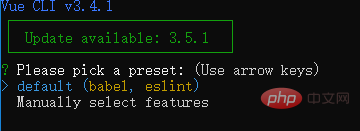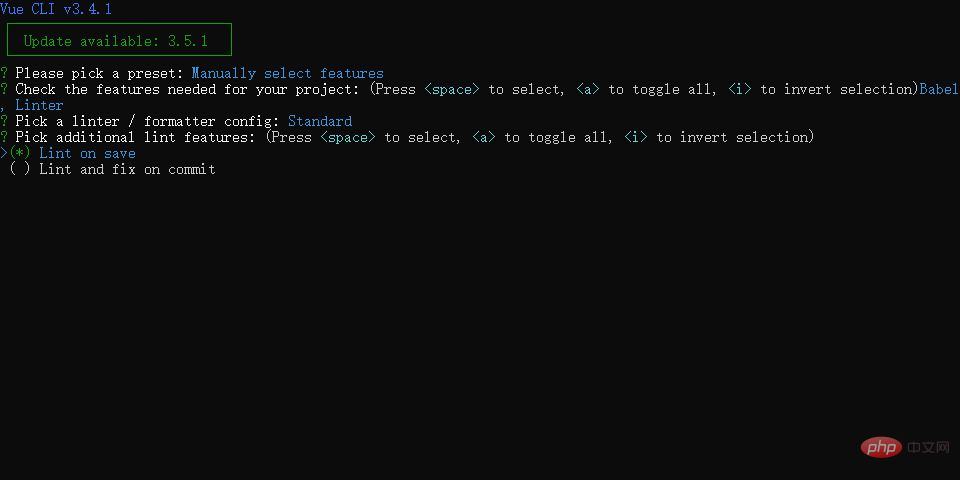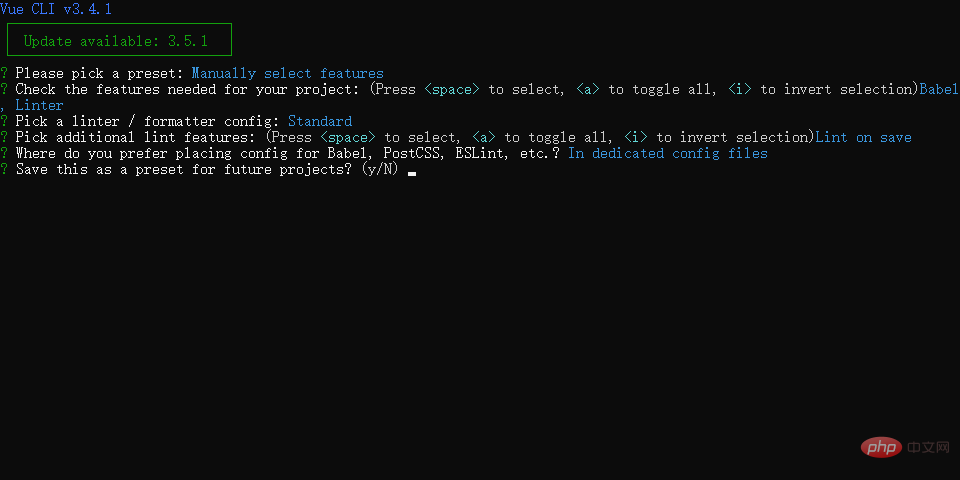 Web Front-end
Web Front-end
 JS Tutorial
JS Tutorial
 vue-cli3.0 installation and configuration tutorial (picture and text)
vue-cli3.0 installation and configuration tutorial (picture and text)
vue-cli3.0 installation and configuration tutorial (picture and text)
This article brings you a tutorial (pictures and text) on the installation and configuration of vue-cli3.0. It has a certain reference value. Friends in need can refer to it. I hope it will be helpful to you. .
Recently, the company is going to start a new project and configure it with vue-cli3.0. Let me do it and make a record.
Installation
First you need to upgrade to cli3.0, the command is as follows. (It is best to go to the official website and read the cli3.0 documentation yourself)
npm install -g @vue/cli-service-global
After the installation is completed, check whether the installation is successful, as shown in the figure below.

If it shows 3.0 or above, the installation is successful.
Create a project
vue create hello-world
During the creation process, you will be asked to select a series of configurations. The up and down keys on the keyboard can be used to switch, the space bar can be selected, and the enter key can be confirmed. I will explain them one by one below.

The first default configuration will only install babel and eslint. Others need to be configured by yourself. It is not recommended. Here we choose the second oneManual configuration. Press Enter (the up and down keys on the keyboard can switch up and down the selection)

From top to bottom they are (note: the space bar can be selected)
babel:用来将es6的代码编译为es5 typescript:javascript的一个超集,我这里没选 Progressive Web App (PWA) Support: pwa技术 Router:路由 Vuex:全局状态管理 CSS Pre-processors: css预处理 Linter / Formatter: 风格检查器 Unit Testing:单元测试 E2E Testing:e2e测试
here The choice can be made according to personal needs
Next step, choose the eslint style. Without further ado, just choose the third standard (I don’t know the first few -_-)

Here I am asking you whether you want to set lint when saving or when submitting. I set lint when saving here (the first one)

This is asking you where to put the configurations of babel, eslint, and postcss.

In dedicated config files:放在相应的文件中 In package.json:放在package.json中
 Here It asks you whether to save the preset. When you choose yes, these settings will be selected by default the next time you execute vue create xxx.
Here It asks you whether to save the preset. When you choose yes, these settings will be selected by default the next time you execute vue create xxx. It is recommended to choose no
Go here The configuration is completed in one step and waiting for the installation to complete.
This article has ended here. For more other exciting content, you can pay attention to the JavaScript Video Tutorial column on the PHP Chinese website!
The above is the detailed content of vue-cli3.0 installation and configuration tutorial (picture and text). For more information, please follow other related articles on the PHP Chinese website!

Hot AI Tools

Undresser.AI Undress
AI-powered app for creating realistic nude photos

AI Clothes Remover
Online AI tool for removing clothes from photos.

Undress AI Tool
Undress images for free

Clothoff.io
AI clothes remover

Video Face Swap
Swap faces in any video effortlessly with our completely free AI face swap tool!

Hot Article

Hot Tools

Notepad++7.3.1
Easy-to-use and free code editor

SublimeText3 Chinese version
Chinese version, very easy to use

Zend Studio 13.0.1
Powerful PHP integrated development environment

Dreamweaver CS6
Visual web development tools

SublimeText3 Mac version
God-level code editing software (SublimeText3)

Hot Topics
 1386
1386
 52
52
 How to implement an online speech recognition system using WebSocket and JavaScript
Dec 17, 2023 pm 02:54 PM
How to implement an online speech recognition system using WebSocket and JavaScript
Dec 17, 2023 pm 02:54 PM
How to use WebSocket and JavaScript to implement an online speech recognition system Introduction: With the continuous development of technology, speech recognition technology has become an important part of the field of artificial intelligence. The online speech recognition system based on WebSocket and JavaScript has the characteristics of low latency, real-time and cross-platform, and has become a widely used solution. This article will introduce how to use WebSocket and JavaScript to implement an online speech recognition system.
 WebSocket and JavaScript: key technologies for implementing real-time monitoring systems
Dec 17, 2023 pm 05:30 PM
WebSocket and JavaScript: key technologies for implementing real-time monitoring systems
Dec 17, 2023 pm 05:30 PM
WebSocket and JavaScript: Key technologies for realizing real-time monitoring systems Introduction: With the rapid development of Internet technology, real-time monitoring systems have been widely used in various fields. One of the key technologies to achieve real-time monitoring is the combination of WebSocket and JavaScript. This article will introduce the application of WebSocket and JavaScript in real-time monitoring systems, give code examples, and explain their implementation principles in detail. 1. WebSocket technology
 How to use JavaScript and WebSocket to implement a real-time online ordering system
Dec 17, 2023 pm 12:09 PM
How to use JavaScript and WebSocket to implement a real-time online ordering system
Dec 17, 2023 pm 12:09 PM
Introduction to how to use JavaScript and WebSocket to implement a real-time online ordering system: With the popularity of the Internet and the advancement of technology, more and more restaurants have begun to provide online ordering services. In order to implement a real-time online ordering system, we can use JavaScript and WebSocket technology. WebSocket is a full-duplex communication protocol based on the TCP protocol, which can realize real-time two-way communication between the client and the server. In the real-time online ordering system, when the user selects dishes and places an order
 How to implement an online reservation system using WebSocket and JavaScript
Dec 17, 2023 am 09:39 AM
How to implement an online reservation system using WebSocket and JavaScript
Dec 17, 2023 am 09:39 AM
How to use WebSocket and JavaScript to implement an online reservation system. In today's digital era, more and more businesses and services need to provide online reservation functions. It is crucial to implement an efficient and real-time online reservation system. This article will introduce how to use WebSocket and JavaScript to implement an online reservation system, and provide specific code examples. 1. What is WebSocket? WebSocket is a full-duplex method on a single TCP connection.
 JavaScript and WebSocket: Building an efficient real-time weather forecasting system
Dec 17, 2023 pm 05:13 PM
JavaScript and WebSocket: Building an efficient real-time weather forecasting system
Dec 17, 2023 pm 05:13 PM
JavaScript and WebSocket: Building an efficient real-time weather forecast system Introduction: Today, the accuracy of weather forecasts is of great significance to daily life and decision-making. As technology develops, we can provide more accurate and reliable weather forecasts by obtaining weather data in real time. In this article, we will learn how to use JavaScript and WebSocket technology to build an efficient real-time weather forecast system. This article will demonstrate the implementation process through specific code examples. We
 Simple JavaScript Tutorial: How to Get HTTP Status Code
Jan 05, 2024 pm 06:08 PM
Simple JavaScript Tutorial: How to Get HTTP Status Code
Jan 05, 2024 pm 06:08 PM
JavaScript tutorial: How to get HTTP status code, specific code examples are required. Preface: In web development, data interaction with the server is often involved. When communicating with the server, we often need to obtain the returned HTTP status code to determine whether the operation is successful, and perform corresponding processing based on different status codes. This article will teach you how to use JavaScript to obtain HTTP status codes and provide some practical code examples. Using XMLHttpRequest
 How to use insertBefore in javascript
Nov 24, 2023 am 11:56 AM
How to use insertBefore in javascript
Nov 24, 2023 am 11:56 AM
Usage: In JavaScript, the insertBefore() method is used to insert a new node in the DOM tree. This method requires two parameters: the new node to be inserted and the reference node (that is, the node where the new node will be inserted).
 JavaScript and WebSocket: Building an efficient real-time image processing system
Dec 17, 2023 am 08:41 AM
JavaScript and WebSocket: Building an efficient real-time image processing system
Dec 17, 2023 am 08:41 AM
JavaScript is a programming language widely used in web development, while WebSocket is a network protocol used for real-time communication. Combining the powerful functions of the two, we can create an efficient real-time image processing system. This article will introduce how to implement this system using JavaScript and WebSocket, and provide specific code examples. First, we need to clarify the requirements and goals of the real-time image processing system. Suppose we have a camera device that can collect real-time image data



